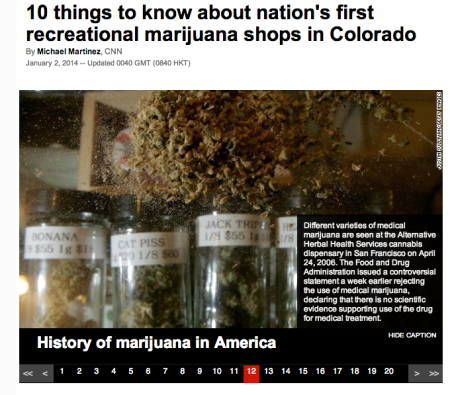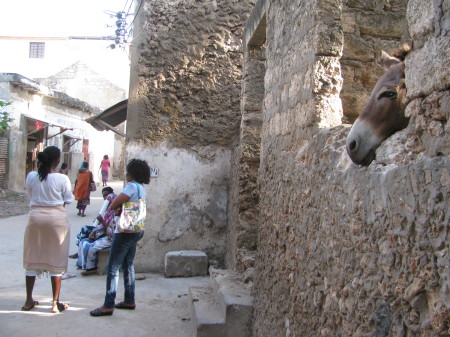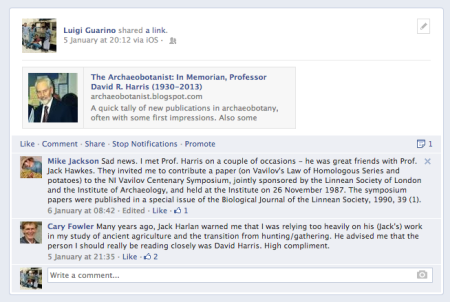There’s one thing I want to know about what’s going to happen now that marijuana has been legalized in a couple of states in the US. And it’s not on CNN’s list. 1 No, not where a visitor can actually smoke the stuff legally, as opposed to just buying it. Or how I can get a job in the industry. What I want to know is what will happen to diversity. There are some indications that legalization may lead to an increase in intellectual property protection over particular strains. I hope someone out there is gathering the baseline data, and saving the seeds, just in case. Not to mention learning lessons that could then be applied to, I dunno, opium in Afghanistan?
Dorian Fuller on domestication, and not only of donkeys
Speaking of Dorian Fuller, in addition to his always fascinating The Archaeobotanist blog, he also curates five — count them — topics on Scoop.it, reflecting the wide range of his interests. Unlike many others on Sccop.it, including me, Dr Fuller always provides trenchant commentary on the material he posts. Browsing through his stuff, I ran across a post on a paper on donkey domestication which I had missed last year. I hope he won’t mind if I reproduce his insights here, to give a flavour of what you can expect if you follow him.
Donkey’s are undoubtedly one of the most important domesticates from Africa, but less well-documented then cattle or many crops, as they have rarely been food sources. This article provides updated review of the archaeology and genetics of donkey, including some ancient DNA evidence such as Uan Muhhgiag donkeys from prehistoric Libya. Of interest is the argument that reports of “wild” donkeys in the Levant or Arabia, such as the quantities from Ash-Shumah in Yemen, are early domesticates and not endemic wild populations. If this is the case then it would put donkey herding back to the early Holocene before 6000 BC, putting them in competition of Bos africanus for the earliest African domesticates [excluding Pleistocene bottlegourds]. Alternatively, as mapped in Boivin & Fuller (2009 in J. of World Prehistory) we extend the map of wild donkeys through the Sinai and down the west coast of Arabia to make the Ash-Shumah remains those of hunted wild animals. The latter would open the possibility of southern Levant donkey domestication. The current review by Kimura, Marshall and colleagues makes an interesting but inconclusive case against this. (Historical linguistic evidence does tend to point to African domestication among Afroasiatic/Cushitic sub-groups). As this paper concludes there is a need for more targetted research on donkeys!
Which also allows me to post one of the pix from my recent holiday on Lamu island off the coast of Kenya, where donkeys are of course the only form of transportation.
Prof. David Harris RIP
Prof. David Harris, one of the giants of the study of the origins of agriculture, died during the holiday period. He was Professor Emeritus of Human Environment at the Institute of Archaeology (UCL) and a former director of the institute (1989-1996). Dorian Fuller, a friend and colleague at the institute, has an informative and touching piece about Prof. Harris on his blog. The comments there, and on my re-posting of Dr Fuller’s piece (see below), are ample evidence of Prof. Harris’ impact and legacy.
Which crops hold the key for climate change adaptation?
To draw greater attention to the role of traditional crops in climate change adaptation, we are conducting a global survey on which crops are stress tolerant and have potential to improve the livelihoods of farmers and communities.
“We” being our friends at Bioversity International. Go on, take the survey. I dare you.
Forestry and agriculture information resources latest
Good news from FAO for all interested in forests and their products:
After much reflection, we have decided to merge the NWFP Digest and Non-Wood News into a single e-publication, which will be distributed quarterly: the present NWFP Update. Whilst possessing many of the same features of its predecessors, we are placing increased emphasis on views and contributions from our readers, with the hope of building a dynamic platform for practitioners to exchange views on NWFPs in the long-run… Finally, we would like to thank Tina Etherington, long-time editor of the NWFP Digest and Non-Wood News who retired last year. Tina provided such momentum to the NWFP “conversation” in previous years through her work and was an inspiration to many.
Happy to add our thanks and congratulations for Tina. You can subscribe from the appropriate FAO Forestry web page.
And since we’re on the subject of data and information, have you heard about agINFRA? It’s all part of this Global Open Data for Agriculture and Nutrition (GODAN) thing. :
agINFRA is pioneering the connection of Agricultural Data through an Open and Participatory Data Infrastructure. Our website is here to provide you with everything you need to know to discover exciting new developments in the field and get yourself or your organization involved.
So now you have no excuse.


